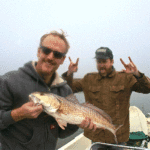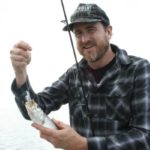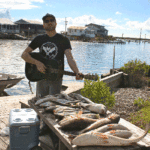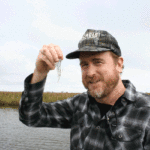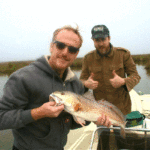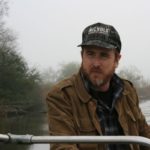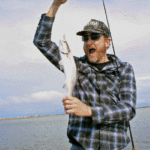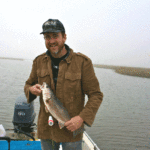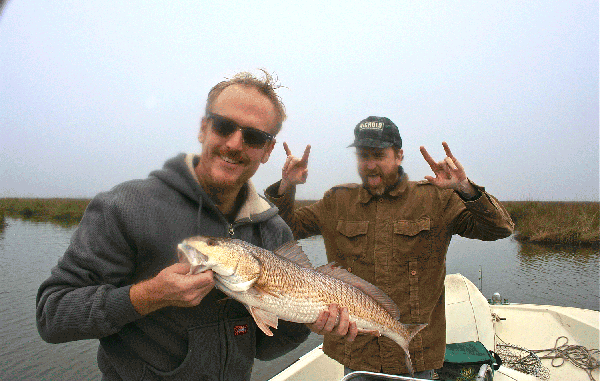
Bill Davis is best known as the guitarist for the band Dash Rip Rock, but when he’s not on the road touring he spends his time fishing in Louisiana’s marshes.
Roughly 15 hours of every day of my childhood were spent fishing in Southwest Florida. In my late teens, I put aside the rod after picking up the guitar.
For the rest of my life, all my friends would be musicians. This pool of musician buddies quadrupled upon my 2001 move to New Orleans.
It wasn’t until recently at the age of 38 that I again heard the call of the water, recognized the void in my life, and started asking around, trying to find musician buddies who could pass on to me the unique secrets of Louisiana fishing.
My recent mentor has been Bill Davis, guitarist and songwriter of the band Dash Rip Rock. After almost 30 years touring the world, Davis was inducted into the Louisiana Music Hall of Fame.
But music isn’t his only joy; he also loves to fish.
Davis first took me out in November to catch some trout on Bayou Dularge. At his buddy’s Dularge fishing camp, Davis had recently written much of Dash Rip Rock’s 16th album, Black Liquor, which addresses many of Louisiana’s ecological issues over a thick bed of snarling guitars.
Known as a hard-partying city boy, Davis bought his own fishing camp in Slidell after Katrina. Finally choosing the sporting life over the nightlife, Davis moved to the camp permanently in 2012.
Dash Rip Rock plays shows throughout the South every weekend, and the trio tour the country once or twice a year.
But when Davis is home, he fishes daily.
At 6 a.m. on this day, I headed out from New Orleans with Davis and photographer Tony Nozero (a drummer for 13 years in the progressive rock band Drums n Tuba), with Davis towing his 17-foot Boston Whaler, with its side console and 90-horsepower Yamaha.
Davis bought the boat, named Swamp Rabbit, with his now-deceased father in 1995.
Like any drive outside of New Orleans, this one to Bayou Dularge south of Houma reminded me that fishing is the state’s premier preoccupation. Every other Louisiana city is populated with eccentrically named fishing camps, many under repair from whatever was the last big storm.
We drove down Highway 315 until there was more water than land to drive upon. A bald eagle flew upward, attempting escape from the thick, grey fog.
Finally, we pulled into Jug’s Bait & Tackle (which, incidentally just added live shrimp to its bait menu). While Davis gassed up the boat, Nozero and I crept around back to check out a wild, black-and-white swamp pig penned beside a large wild turkey.
Tides were scheduled for 6 a.m. and 6 p.m. We launched at 8 a.m., setting out on a 40-minute boat ride to Bill’s favorite redfish pond.
Because the marshlands change and shift continuously, Davis doesn’t bother with GPS.
On the boat ride out, Davis worried aloud that he would fail us.
“It’s a weird transitional day,” he warned.
A cold front had earlier dumped rain on Dularge, then stalled over Grande Isle, threatening to move back toward the north. For now, the water temperature was in the 50s and the air around 60 degrees, progressing on up to afternoon 80s.
Davis said a south wind was supposed to come in and move the water soon, but for now the fog remained thick.
I ignored Davis’ claim that fishing on Dularge had recently been poor, since other sources had reported the opposite — that the warm winter weather had the trout schooling everywhere.
Weather.com stated we’d missed the 7 a.m. peak, but that fishing would be good all day. And, knowing from experience that a Louisiana native’s “bad day fishing” can mean catching “only” a couple big redfish, I focused instead on the sights.
Several dolphin played in the supremely glassy water. Davis, who had never seen a dolphin on Dularge, said it was a good sign for the water’s salinity, which was in turn good for trout. The bright grey horizon was decorated with dozens of pelicans, egrets and cormorants.
There was just too much morning activity on the bayou for us to have a bad day fishing.
Redfish
We ran Bayou Dularge to Mud Lake and hooked a right into Bayou Dufrene. As we neared Davis’ pond, we spotted the wakes of two giant reds cruising the shore perpendicular to our boat, as if trying to beat us to the spot.
A friend had given me a fresh-out-the-box Daiwa Laguna 100 reel and Daiwa 7-foot Aird 701MLXB rod, and I was excited at the prospect of catching a big red on 10-pound Berkely line.
When we reached the pond, Bill broke out a fresh package of three Tsunami Holographic Shrimp.
“These things are always sold out when I go looking for them in Louisiana,” said Davis. “But Dash Rip Rock was on tour in Alabama and we had to get a flat tire changed, and while I was at Wal-Mart waiting I noticed they had Tsunami Shrimp. I guess people in Alabama don’t know about them yet.
“I stocked up. That’s the beauty of touring.”
We anchored where the bayou emptied into the pond in still, shallow water, close to shore. Bill rigged us each up with a Tsunami lure, about a foot down from a popping cork.
“People assume you have to be quiet when you are fishing,” Davis said, “but in my experience, popping the cork real hard gets fish interested, especially reds and trout.”
Davis’ cork style had me constantly looking over, thinking he had a fish. Half the time he did.
We warmed up with some large sheepshead, 3 and 4 pounds apiece. Some in Louisiana don’t respect the sheepshead like we did back in Florida; sheepshead eat so much crab that they almost taste like crab, and make a great substitute in crab cakes.
For a moment, we were all distracted watching a roseate spoonbill feed on the marsh. As it alighted pale pink through the pale, grey fog, I hooked the first large fish of the day: a 27-inch red.
My new Daiwa Aird rod was so long and thin that I had to pull back dramatically to set the hook on every fish of the day. The Laguna 100 reel, however, handled the big red well.
Despite all my childhood experience in Florida, I do not think I’ve ever caught a more beautiful fish.
I casted my Tsunami Shrimp back out into the exact same spot, and not five minutes later I caught another big red. We then all attempted to fish atop one another in that same small hole, where Tony and Bill each nailed one more big red apiece.
Eventually the action died — until Bill moved us down the marsh just a wee bit to another pond, and found he and Tony each another 24-inch red.
By then, sensing a monumental day, we were throwing big, beautiful sheepshead back into the water. The streak went around the boat until all three of us had two big, gorgeous reds apiece — all at least 24 inches.
The overcast sky was not only beneficial to redheads such as myself and Davis — intensive fishing has burdened us both with melanomas — but the grey sky also helped our hunt for redfish.
“Reds are spooky fish,” Davis said, “and if it’s sunny they can see you.”
Luckily for us, visibility must have been as foggy under the water as it was above.
When the sun finally arrived, we lost the redfish completely. Still, I had rarely been in the company of happier people. With the sun shining and the fog dispersing, Davis offered to take us to the oyster beds for trout, and we headed out in a different direction.
Trout
For trout, we headed out into the mouth of Snake Bayou, in the direction of the abandoned conservation camp on Sister Lake.
Boating about 30 minutes through Sister Lake to the Gulf of Mexico proper would take you to Last Island, which was once a posh resort area hosting hotels with grand ballrooms — until in 1856 a Category 4 hurricane swept through, killing 200 people, as documented in Lafcadio Hearn’s book Chita: A Memory of Last Island.
Tony and Bill stuck with the Tsunamis, and I changed over to H&H’s 3-inch chartreuse sparkle beetle — which sounds like the name of a New Orleans burlesque dancer, but in fact is the default lure of most of my fishing musician buddies.
Davis let the boat drift, hoping to float directly over “oyshter beds.” In 6 to 7 feet of water, we’d cast, pop the cork, let it sit five seconds, pop, sit five, pop.
Within 15 minutes we’d caught a dozen trout — both white and speckled versions — between us. The first keepers all needed to be measured.
We could tell we were over an oyster bed whenever, suddenly, we no longer needed to measure the trout, and when we did they were generally upwards of 15 inches.
Repeating that slow drift twice, we were successful enough that I always threw back any trout that needed measuring.
Birds were our companions throughout the fruitful day: Just as we spotted some swan-type bayou bird which I’ve even since failed to identify, I hooked into something extra large. It turned out to be a black drum that, though it was roughly 7 pounds, felt just right on my light Daiwai trout tackle.
Unfortunately, the biggest fish of the day turned out, later on the cutting board, to be so skinny and riddled with white tube worms that I couldn’t salvage the small fillets. The meat from all of the other fish, however, was perfect.
Around 1 p.m., the sun replaced any wind, which ushered in the bugs. A friend had drawn Davis a map to another spot, based on the advice of Dularge charter boat Capt. Bill Lake.
Cityboy Davis felt intimidated by the prospect of navigating the ever-shifting bayou via sketches on a cocktail napkin, and decided we should call it a day. Perhaps we should have tried the map; on the phone later, Lake reported his six-man team that same morning had caught 19 redfish and 150 trout using largely the same methods we had.
But we’d been granted more calm that day than the forecasts had predicted, the weather had served us well and now the bugs were ending one of the best fishing trips of my life.
We boated back to Jug’s, and then towed the boat back to the city — our cooler full of fish (two reds apiece, 16 trout, six sheepshead and a huge black drum), and our heads full of beautiful Bayou Dularge memories.
